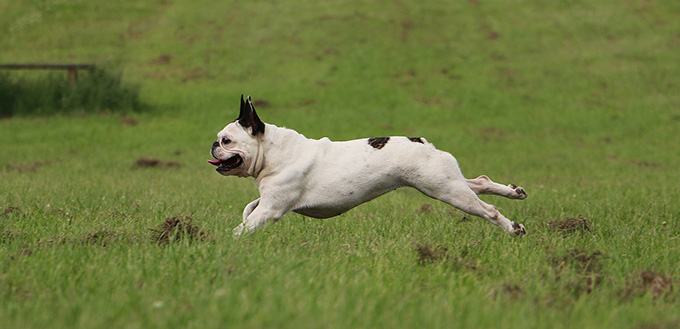There are certain breeds of dogs that are more susceptible to problems in the joints which can significantly impair their mobility, make them more prone to musculoskeletal injuries, and adversely affecting their quality of life. While senior dogs are almost always expected to have joint problems, even younger pooches are not immune to joint problems especially if it’s already in their genetic makeup. This can adversely affect their behavior and the way they enjoy your companionship and the social relationship they have with other dogs. Thankfully, there are several supplements that can help enhance the full functionality of the joints. One of these is glucosamine. In this article, we will be exploring a bit more about this particular substance that has become one of the mainstays in many canine formulations for both nutritional supplements and joint health supplements.

A Look at Dog Joints
First, let us try to have a look at the normal anatomy of a healthy dog joint. This is crucial because our understanding of the need for glucosamine is greatly anchored on how well we understand the normal anatomy and physiology of our dogs’ joints.
Joints are the connections between bones that are brought together and secured in place by other supporting tissues. In dogs, there are three types of joints. These are the following.
- Synovial joints
These types of articulations are the most common and these essentially function in ensuring optimum mobility for dogs. Synovial joints are located at the junction of two opposing bones that allow for the greatest range of motion. Since there are two bones, the surfaces of the ends of these bones are covered with a connective tissue known as cartilage. You can look at cartilage as a softer version of a bone.
There is a fibrous and tough connective tissue that encapsulates both ends of the opposing bones. There are also strands of very tough, fibrous ligaments that hold both bones in their respective positions. These ligaments are located both inside and outside the joint capsule. Inside this capsule is a space or a cavity that is filled with synovial fluid. One can always understand the joint as similar to a hydraulic pump mechanism whereby two opposing surfaces are kept within a particular confinement and lubricated by hydraulic fluid. The same is true with synovial joints.
Examples of synovial joints are those at the hips and the jaw.
- Cartilaginous joints
These types of joints allow for some degree of movement, but definitely lesser than the movement afforded by synovial joints. These are characterized by the absence of a joint capsule which joins one bone to another. Instead, the two bones are connected by a cartilage. Examples of these types of joints are those formed by the spine.
- Fibrous joints
If synovial joints allow maximum range of motion, fibrous joints are the exact opposite. There is little movement if any at all. Instead of a synovial capsule or even cartilage joining two bones together, these are joined by very tough fibrous connective tissue. An excellent example of this type of articulation is the bones of the dog’s skull. Just imagine if these were made of cartilaginous or even synovial joints and your mutt won’t have adequate protection for its brain and other structures inside the skull.
Since we are talking about canine joint problems in the context of mobility, we will be focusing more on the synovial type of articulations. We know that these types of articulations are heavily dependent on the optimum functioning of 3 different elements, namely:
- Synovial membrane
- Cartilage
- Synovial fluid
A problem in any of these elements can lead to a problem in the joint which can lead to a problem in mobility. For example, a tear in the synovial membrane will lead to the leakage of synovial fluid outside, drying it up, and making joint movement a lot more difficult. A problem with the cartilage at the ends of bones can lead to a less smooth movement, creating pain as your dog moves. If synovial fluid is decreased, there is no mechanism that will help prevent the two articulating surfaces from rubbing against each other. This also leads to painful movement.
As you can see, any change in these three elements can significantly affect the health and functioning of your pooch’s joints.
Cartilage is formed by chondroblasts and maintained by chondrocytes which are dependent on a variety of substances including collagen and proteoglycans. Chondrocytes are also responsible for the production of lubricin which is added into the synovial fluid. On the other hand, synovial fluid is secreted by the synovial membrane and mostly contains hyaluronan, lubricin, and interstitial fluid. Together, these form the basic functions of synovial fluid which include:
- Reduction of frictional forces
- Shock absorption
- Molecular filtration or sieving
- Nutrient transportation and waste removal
Hyaluronan is a type of nonsulfated glycosaminoglycan. It is this substance where glucosamine can play a very important role in maintaining the optimum functioning of your dog’s joints.
Why Canine Cartilage Needs to be Protected
Based on what we understand so far about articular anatomy, the ends of the long bones of dogs are covered in cartilage which plays a role in the production of a part of the lubricating substance in the joint capsule. It is important to protect the cartilage at all cost since the long bones are generally subjected to tremendous concussive forces.
Cartilage, in this case, serves like a cushioned padding for your bones so that when compressive forces are applied, the very dense ends of the two bones don’t rub against each. This helps prevent fractures. It also helps prevent pain as bone is naturally filled with nerves. If there is no padding in between the two bones, pressure applied on the ends of these structures will be interpreted as pain. With the padding the pain receptors are not stimulated. So, when your dog jumps from the bed, the sofa, or even your truck’s flatbed, it will not feel pain in its joints for the simple fact that cartilage is there to both absorb the impact force and protect the two opposing surfaces of bones.
Understanding Chondroprotectives
Now that we have a fair idea of how a dog’s joint looks like and why we need to protect the cartilage at all cost, it is time to focus our attention on a class of substances that have been gaining widespread attention for the past few decades.
Glucosamine and chondroitin are now considered as mainstays in ensuring optimum joint health and not just in the management of joint pain. These substances have been used by man for the management of a variety or articular problems. Recent studies show that these benefits to man can also be extended well to dogs and even cats as they all basically have the same anatomic arrangement of articular structures.
Together, these substances are known as chondroprotectives since their main goal is to protect and preserve the full functionality of the chondrocytes – those cells that maintain the structure and function of cartilage. These are different from chondroblasts which are involved in the building of cartilage while chondroclasts are needed for the destruction of cartilage so that these can be repackaged and built by chondroblasts again. Technically, chondroprotectives – glucosamine and chondroitin and to a certain extent methylsulfonylmethane or MSM – work to improve the functioning of chondrocytes to bring about the following effects:
- Increased production of synovial fluid
- Reduction of stimulation of pain receptors with movement
- Reduction of inflammation of the articular surfaces
- Optimization of range of motion
Uses of Glucosamine for Dogs
It should be fairly obvious what glucosamine for dogs is for. Here, we have summarized some of the key uses of glucosamine for your pet pooch.
- Alleviation of pain associated with musculoskeletal problems
Dogs with hip dysplasia can benefit a lot from the administration of glucosamine. Since the major issue with canine hip dysplasia is the incorrect fit of the head of the femur into the pelvic socket called the acetabulum. Normally, both of these surfaces are covered with cartilage to provide a smoother and wider range of motion. In hip dysplasia, these surfaces may not be smooth at all, mostly severely misshapen. While the dog’s body is able to compensate by producing more cartilage, courtesy of the chondroblasts and chondrocytes, it takes a rather long time. With each movement of your dog, the cartilaginous surfaces get degraded even more. This starts a vicious cycle of damage to the cartilage followed by inflammation and the onset of pain. The more damaged the cartilage gets the less able is the cartilage to repair itself.
Glucosamine helps reduce the pain in these surfaces by providing the necessary framework for chondrocytes to increase the rate upon which chondrocytes can repair the cartilage. The faster the cartilage is repaired, the faster the resolution of the inflammation, and the lesser is the occurrence of pain. Additionally, since chondrocytes are involved in the production of synovial fluid, they can help in improving the lubrication within the joint capsule, effectively dampening shock forces so they don’t reverberate through the synovial capsule. Likewise, since osteoarthritis is a very common complication of hip dysplasia, the introduction of glucosamine can also help relieve the pressure off of these articular surfaces, allowing your dog to move independently.
- Adjunctive treatment in cases of injury to the dog’s spinal disc
We learned that the joints in the spinal column are actually composed of cartilaginous tissues. Degenerative disc disease is quite common in dogs. The problem lies in the intervertebral discs or the equivalent of synovial capsules in synovial joints. Some breeds are more susceptible to intervertebral disc degeneration resulting in the spinal cord getting crushed or pinched by the fragments of the degenerating disc. This causes pain as well as paralysis depending on the location of the injury.
The treatment for degenerative disc disease is surgery. This is performed to relieve pressure off of the spinal cord. Fragments are also removed. Since glucosamine helps improve the functioning of chondrocytes – the keepers of cartilage – then it should be able to help promote the faster regeneration of vertebral injury to dogs.
- Surgical recovery
Dogs that have undergone joint surgery can also benefit from the chondroprotective nature of glucosamine by boosting the function of chondrocytes in the formation and maintenance of the articular surfaces while also adding to the synovial fluid. This relieves strain on the 2 opposing articular surfaces so that the surgical wound will be allowed to heal properly.
- Peak physical performance
Your dog doesn’t need to have a joint disease before you start giving it glucosamine. As we have already learned, this substance can help improve the overall functioning of chondrocytes leading to greater range of motion. This easily translates to faster runs, higher jumps, and more meaningful walks without your pooch ever feeling pain in its joints. And if you have a dog that is built to compete, this is surely a great way to boost its performance.
How Glucosamine Works
We have been discussing the indications of glucosamine and it should already be clear how it works. First, glucosamine stimulates the chondrocytes to keep on producing glycosaminoglycans which are very important in ensuring the integrity of the entire joint capsule. These combination of sugars and proteins help provide the necessary structure upon which the joint capsule draws its strength.
Secondly, glucosamine indirectly stimulates chondrocytes to synthesize collagen, a protein that is involved in the formation and maintenance of the extracellular matrix. It is collagen that provides the structural strength in the capsule.
Thirdly, we also mentioned that chondrocytes produce lubricin which is added into the synovial fluid. Technically, glucosamine is indirectly responsible for the lubricating properties of synovial fluid. This helps reduce friction while also providing a safety cushion against concussive forces.
Fourth, glucosamine, since it is a type of glycosaminoglycan, can be used by the chondrocytes of the joints to produce hyaluron or hyaluronic acid which is the principal component of synovial fluid.
Now imagine putting all of these together and you’ve got a powerhouse of a molecule in glucosamine.
Benefits of Glucosamine for Dogs
Based on what we have been discussing so far, we can say that glucosamine can provide a host of benefits. Here are some of the more popular ones.
- Reduces inflammation and alleviates pain
The mere fact that glucosamine can improve the ability of cartilage to repair itself simply translates to lesser cycles of inflammation and pain. Remember what we said about joint disorders being a cycle of cartilage damage and inflammation culminating in pain before cycling back to more cartilage damage? If glucosamine can help hasten the speed upon which the cartilage can be repaired, then the incidence and frequency of inflammation and pain will naturally subside, too.
- Promotes healthier joints and increasing range of motion
Glucosamine promotes the optimum health and functioning of chondrocytes which we know now to be very important in the maintenance of the integrity of the joints. While your pooch may not have joint disease, strengthening the joints is one of the keys to making sure your dog is free from any harm that is associated with these types of canine conditions. Moreover, the improvement in chondrocytic activity helps facilitate the enhancement of mobility, allowing your dog to enjoy what it does best.
- Reduces the need for NSAIDs
While it takes some time before you can notice any pain-relieving effects or anti-inflammatory effects of glucosamine, you can nevertheless be certain that its effects are longer-lasting than NSAID pain relievers. These medications work very fast. However, their effects wane just as fast. Moreover, these can produce a variety of side effects that might undermine the already-compromised state of your dog. On the other hand, glucosamine is completely natural and will not pose any threat to your dog. If your dog is in tremendous pain, go on ahead and give it NSAID. Do give glucosamine, too. Once the pain has been managed, you can stop the NSAID and continue with the glucosamine. There should be no more pain from now on as glucosamine will already be working its wonders in your dog’s joints.

How to Give Glucosamine to Dogs
The beauty of today’s glucosamine formulations for dogs is that it comes in a variety of preparations. This is done to make sure you have plenty of choices. Many dog foods – both dry and canned – are already fortified with glucosamine. As this is already part of its diet, then supplying its joints with glucosamine is relatively easy. There are also dog treats and nutritional supplements that are fortified with glucosamine. And then there are supplements that contain only glucosamine as well as MSM and chondroitin. The point of the matter is that you will never have any problems giving glucosamine to your dog as you’ve got plenty of options. Just don’t give glucosamine designed specifically for humans. That’s a big no-no.
Glucosamine is one of 3 substances that are used in promoting optimum joint health, alleviating pain and reducing inflammation in articular problems, and improving a dog’s overall mobility. It is safe and is available in many dog nutrition products. When it comes to the health of your dog’s joints, glucosamine will never let your dog down.
Related Post: Best Dry Dog Food
Sources:
- Jennifer Coates, DVM, Nutritional Supplements for Joint Health, PetMD
- Dr. Angela Mazza, Joint Supplements – Are They Worth It?, The MSPCA–Angell
Note: The advice provided in this post is intended for informational purposes and does not constitute medical advice regarding pets. For an accurate diagnosis of your pet's condition, please make an appointment with your vet.







